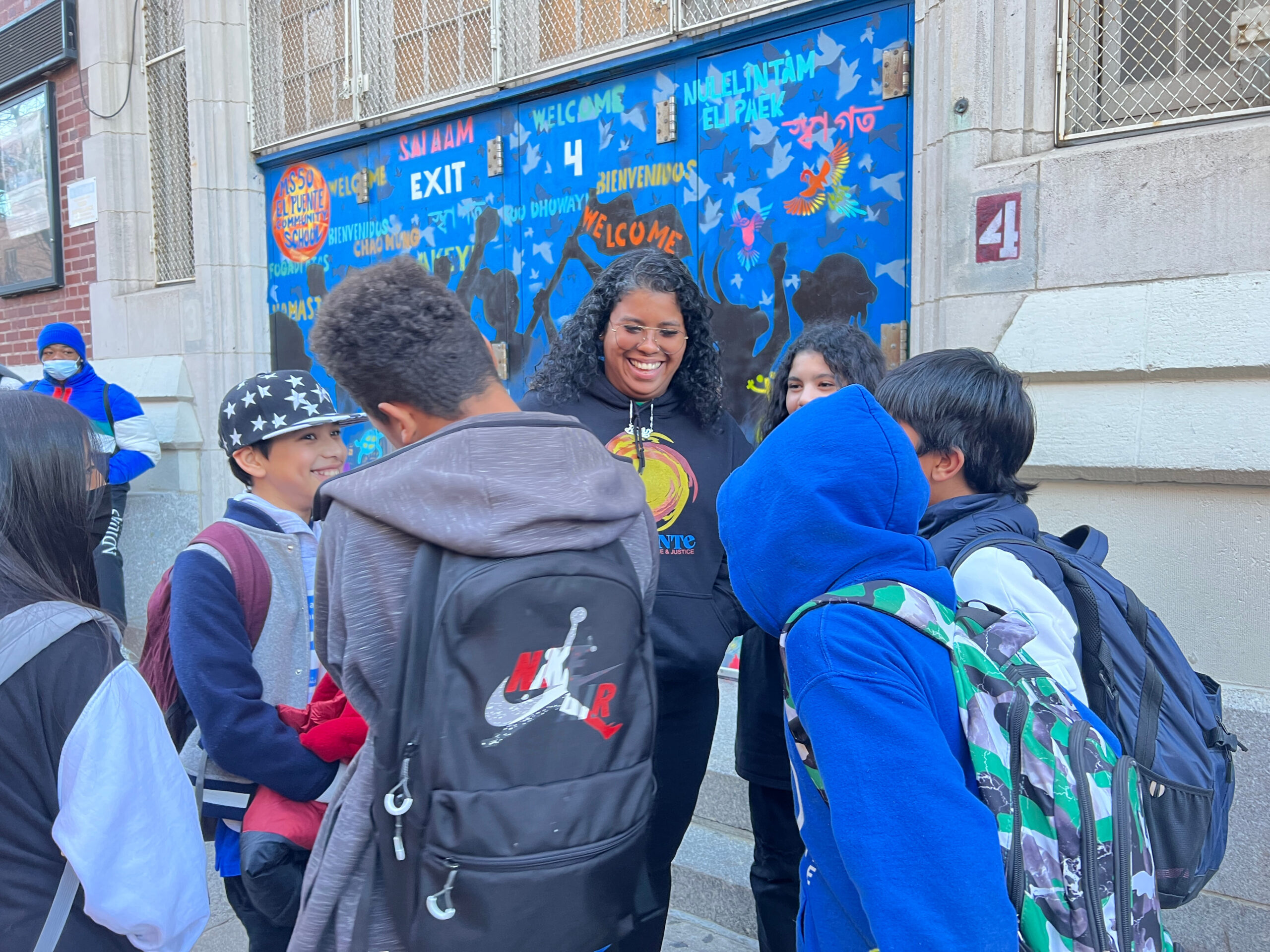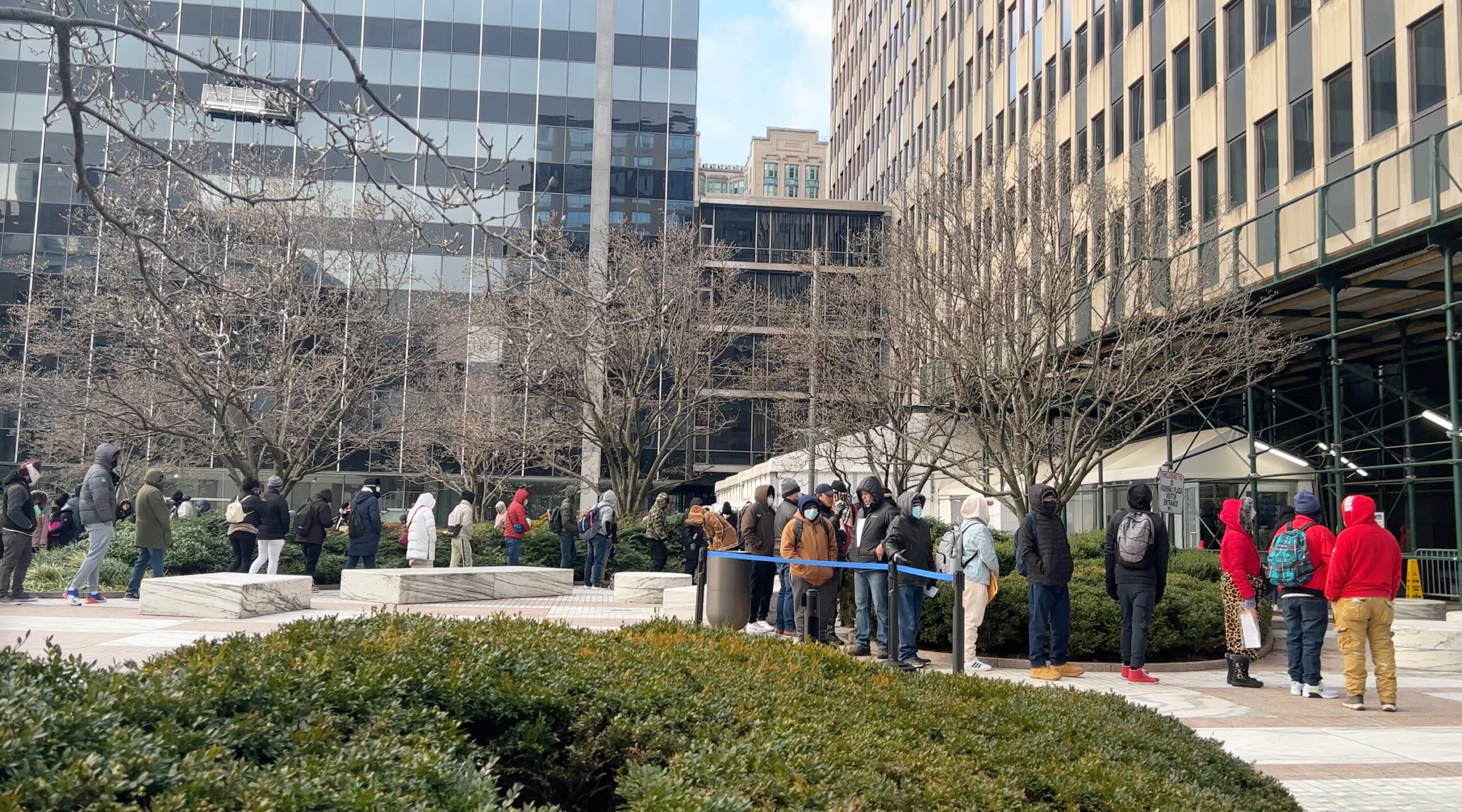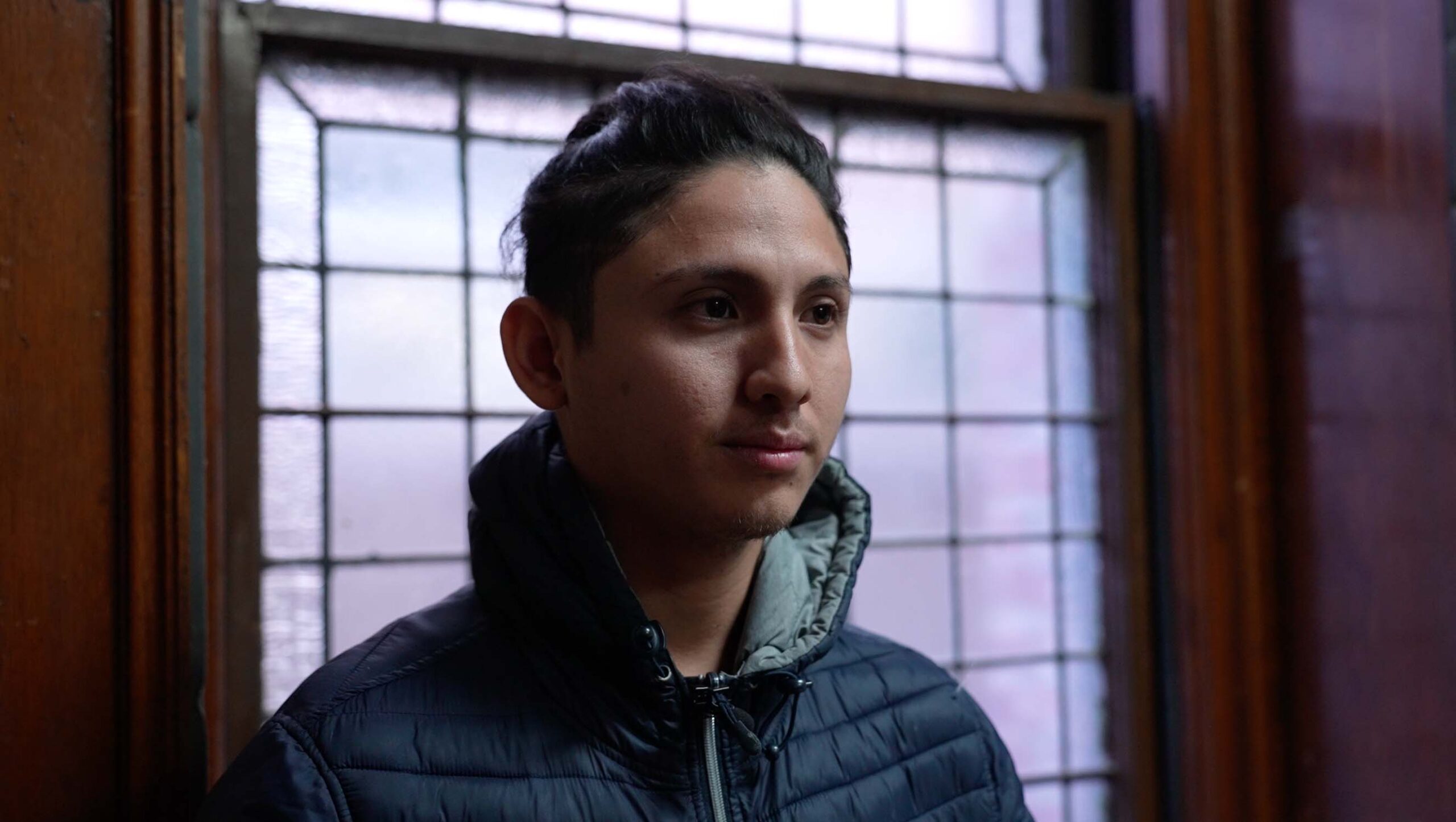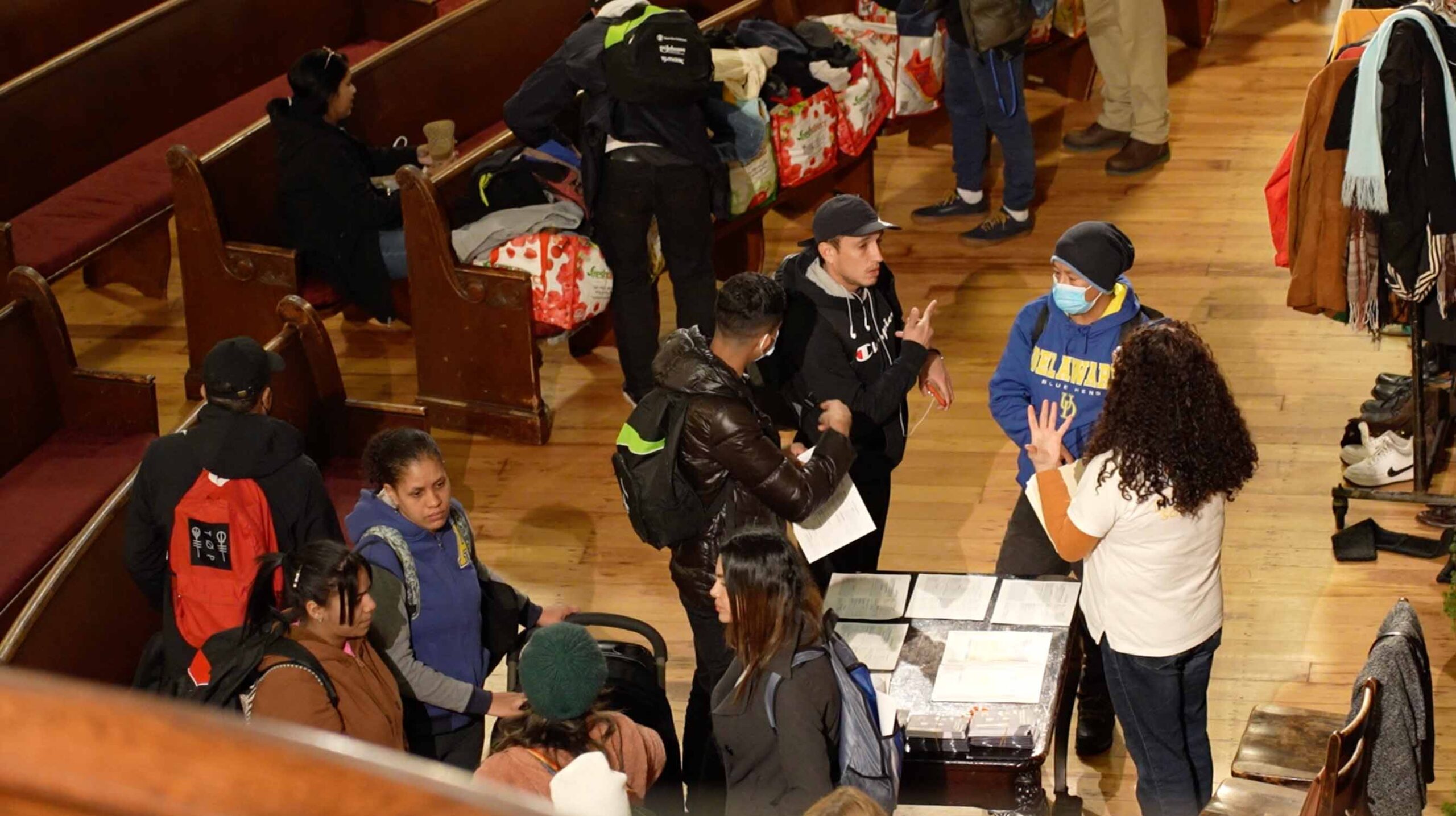Language for All
By Ke Chen
Around 2:30 on a sunny afternoon last week, the children’s laughter filled 183 South 3rd Street as the bell rang, bringing everything around the building to life. Anelin Flete, Community School Director from MS 50 El Puente Community School, was surrounded by a group of newly arrived students, seeing them off in front of the school gate.

Anelin Flete, chatting with migrant students about their school life. Photo by Ke Chen.
More than 27,000 Venezuelan asylum seekers have been sent to New York City since the spring, the majority of them coming with nothing. Fortunately, many communities in the different boroughs of New York City speak Spanish, which provides these newcomers with a sense of familiarity and helps them adjust quickly to their new life in the city.

The waiting line in front of the U.S. Immigration and Customs Enforcement. Photo by Ke Chen.
“When they [migrant students] know people who speak their language or people from their places after they just got here, they feel safe. And that is a mission of El Puente,” said Bernardo Rodríguez, speaking through a translator, Efren Olson-Sanchez. They are both members from El Puente and now work as academic tutors at MS 50 El Puente Community School in Brooklyn.
Until now, MS 50 El Puente Community School has taken in 16 asylum seeker students aged 10 to 14. The school is responding proactively to help these children and the 16 families behind them before winter comes, providing clothing, legal resources, and educational information.
But even though Spanish is the most spoken language in New York besides English, the difficulties caused by not being able to master English have arisen over time for migrants of all ages.
Flete mentioned that one of her newly arrived migrant students, Dana, reached the age to apply to a high school, but she does not have the opportunity because the Specialized High Schools Admissions Test is in English, which she does not know.
To solve the language barrier, MS 50 El Puente Community School started to offer a Spanish dual language program in every grade level. It differs from a bilingual special education program it has, which teaches English and separates the students according to their needs. The dual language class is a regular class but is either taught in English or Spanish, allowing these new students to interact with the local students, and all of them will master two languages.
“They have to learn English; they live here,” Olson-Sanchez added. He teaches art in Spanish and partners with another tutor to transfer words into English so migrant students can build up their vocabulary.
However, an issue arises in dual language classes. “The biggest need and those kids are saying it themselves, is that they feel weird. Because right now, they’re sitting together in the classroom, all the other kids sit together, and the two groups seem separated. So they still feel the isolation. They’re complaining about it. We don’t want that too,” said Flete.
“So the principal and I are currently working together to figure out how we can utilize our funding to bring tutors, specifically bilingual tutors, into classes,” Flete added, “These tutors can help migrant students understand the material and immerse into the culture and talk to the other kids. But that’s expensive.”
Project Open Arms, announced by the city government this year, provides financial assistance for schools that accept migrant students. The school will receive $2,000 per newly enrolled migrant student. MS 50 El Puente Community School recently received $28,000 from project Open Arms and an additional $30,000 from Dream Team. But more funding for supporting immigrant students is needed.
Although MS 50 El Puente Community School is under financial pressure, the migrant students feel very safe within the new community. They come to school every day, and their English skills will be improved during their studies. But for those over school age, their language barrier means an inability to access crucial information, which can be inconvenient in different ways. Using a mobile translation app that requires the internet cannot solve the problem.
Before Jorman Vasquez, 22, came to New York City this summer, he didn’t speak a word of English other than his name. After four months in the city, he can introduce himself in English briefly.

Jorman Vasquez shared his experience of learning English. Photo by Ke Chen.
“I feel funny when I can’t talk to people who don’t speak Spanish here. I have to take out my phone and communicate through the translator. But I’m learning now,” said Vasquez. Now he stays in a church and takes classes offered by the Church and his Mexican friend.
In addition to everyday communication, using English can significantly help migrants find jobs.
“Even if I already have working permission, I would still want to learn English because it would be beneficial for my work,” said Anthony Guzman, 26, a roommate of Vasquez, “I could be a receptionist if I speak English.”

Anthony Guzman talked about his concern about language issues. Photo by Ke Chen.
In response to this challenge, the city offers different solutions. Churches, nonprofit organizations, public libraries, and government-managed programs across five boroughs have created spots to meet the demand.
One busy Monday morning last month, Venezuelans and Immigrants Aid (VIA) partnered with St. Paul and St. Andrew United Methodist Church, delivering free clothes and immigration-related information to a steady stream of refugees waiting in the hall. In one of the flyers provided by VIA, there is information about how to apply for free English classes.

VIA helped migrants on a Monday morning in November. Photo by Ke Chen.
VIA divides its free English classes into three batches: the advanced level for the VIA volunteers, the intermediate level, and one for kids and older people to help newly arrived community members increase the likelihood of better opportunities in the United States.
Hector Arguimzones, one of the co-founders of VIA, pointed out that if migrants “don’t learn English, probably in a city like New York City that has a large Spanish community, they won’t have problems, but they will find obstacles to work in terms of finding opportunities outside the Spanish community.”
When Arguimzones first came to New York City with his family seven years ago, he practiced his English in free classes offered by a public library. Today he helps more refugees from Venezuela through English.
Arguimzones pointed at the doors of the Church Hall, “I was talking to a guy [a migrant] this morning. If you speak only one language, Chinese or French, you will probably have only one door open, but English can open all these doors.”
One of VIA’s Saturday online English classes is with ESL (English as a second language) teacher Tilla Alexander for Venezuelans with intermediate to basic language skills. Each session consists of 10 classes held each Saturday from 11 a.m. to 1 p.m. Participants will receive a certificate of attendance after participating in all classes.
“We usually limit the number of students in a class to six or eight to ensure that the teacher can take care of every student,” said Arguimzones.
VIA does not just offer English language courses; it provides a full range of assistance to Venezuelan refugees. To apply for the course, they need to fill out a Google form in Spanish, which includes, in addition to some basic information, the following: Are you seeking asylum? Are you looking for work? What is the level of study in Venezuela, and what are the most significant challenges you encounter as a migrant in the United States?
Unlike NGOs such as VIA, which helps refugees through many aspects, the Riverside Language Program provides free full-time English classes, especially for newly arrived immigrants, refugees, and asylum seekers in New York City, with a class size of about 20 students.
However, Riverside’s English classes have more stringent application requirements and a more developed and intense curriculum.
For example, applicants must meet five conditions to apply. They must be over 18 years old, live in New York, apply for permanent residency or asylum, and be refugees, asylum seekers, or green card holders for less than three years. They must be able to attend the program in person full-time, Monday through Friday, 9 a.m. to 3 p.m., for six weeks. There is also a preschool test and a final test.
Notably, Riverside’s programs are designed to be very hands-on. For example, the curriculum includes civic education, IT mentoring, and job readiness workshops that refer community partners to potential job placements.
Although 1.87 million residents speak Spanish in the city, Vasquez still thinks it is essential to learn English. “English is a universal language. If you’re from China and don’t speak Spanish, and I’m from Venezuela and don’t speak Chinese, then we can communicate in English.”
In the face of the influx of Venezuelan refugees, many immigrants are making efforts to create a diverse and welcoming environment for newcomers through English. With this help, migrants are ready to start their new chapter of life.
Efren Olson-Sanchez said the enthusiasm among new refugees is palpable.
“When the [migrant] kids came here for the first time, they wanna see it all. They are super open. They want to fit in. They wanna eat the whole city in one bite,” said Olson-Sanchez.